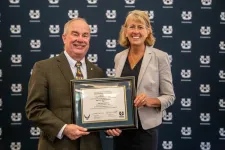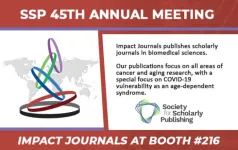(Press-News.org) Researchers at UCLA Health and Harvard have identified 10 pesticides that significantly damaged neurons implicated in the development of Parkinson’s disease, providing new clues about environmental toxins’ role in the disease.
While environmental factors such as pesticide exposure have long been linked to Parkinson’s, it has been harder to pinpoint which pesticides may raise risk for the neurodegenerative disorder. Just in California, the nation’s largest agricultural producer and exporter, there are nearly 14,000 pesticide products with over 1,000 active ingredients registered for use.
Through a novel pairing of epidemiology and toxicity screening that leveraged California’s extensive pesticide use database, UCLA and Harvard researchers were able to identify 10 pesticides that were directly toxic to dopaminergic neurons. The neurons play a key role in voluntary movement, and the death of these neurons is a hallmark of Parkinson’s.
Further, the researchers found that co-exposure of pesticides that are typically used in combinations in cotton farming were more toxic than any single pesticide in that group.
For this study, published May 16 in Nature Communications, UCLA researchers examined exposure history going back decades for 288 pesticides among Central Valley patients with Parkinson’s disease who had participated in previous studies. The researchers were able to determine long-term exposure for each person and then, using what they labeled a pesticide-wide association analysis, tested each pesticide individually for association with Parkinson’s. From this untargeted screen, researchers identified 53 pesticides that appeared to be implicated in Parkinson’s – most of which had not been previously studied for a potential link and are still in use.
Those results were shared for lab analysis led by Richard Krolewski, MD, PhD, an instructor of neurology at Harvard and neurologist at Brigham and Women’s Hospital. He tested the toxicity for most of those pesticides in dopaminergic neurons that had been derived from Parkinson’s patients through what’s known as induced pluripotent stem cells, which are a type of “blank slate” cell that can be reprogrammed into neurons that closely resemble those lost in Parkinson’s disease.
The 10 pesticides identified as directly toxic to these neurons included: four insecticides (dicofol, endosulfan, naled, propargite), three herbicides (diquat, endothall, trifluralin), and three fungicides (copper sulfate [basic and pentahydrate] and folpet). Most of the pesticides are still in use today in the United States.
Aside from their toxicity in dopaminergic neurons, there is little that unifies these pesticides. They have a range of use types, are structurally distinct, and do not share a prior toxicity classification.
Researchers also tested the toxicity of multiple pesticides that are commonly applied in cotton fields around the same time, according to California’s pesticide database. Combinations involving trifluralin, one of the most commonly used herbicides in California, produced the most toxicity. Previous research in the Agricultural Health Study, a large research project involving pesticide applicators, had also implicated trifluralin in Parkinson’s.
Kimberly Paul, PhD, a lead author and assistant professor of neurology at UCLA, said the study demonstrated their approach could broadly screen for pesticides implicated in Parkinson’s and better understand the strength of these associations.
“We were able to implicate individual agents more than any other study has before, and it was done in a completely agnostic manner,” Paul said. “When you bring together this type of agnostic screening with a field-to-bench paradigm, you can pinpoint pesticides that look like they're quite important in the disease.”
The researchers are next planning to study epigenetic and metabolomic features related to exposure using integrative omics to help describe which biologic pathways are disrupted among Parkinson’s patients who experienced pesticide exposure. More detailed mechanistic studies of the specific neuronal processes impacted by pesticides such as trifluralin and copper are also underway at the Harvard/Brigham and Women’s labs. The lab work is focused on distinct effects on dopamine neurons and cortical neurons, which are important for the movement and cognitive symptoms in Parkinson’s patients, respectively. The basic science is also expanding to studies of pesticides on non-neuronal cells in the brain – the glia – to better understand how pesticides influence the function of these critical cells.
Other authors include Edinson Lucumi Moreno, Jack Blank, Kristina M. Holton, Tim Ahfeldt, Melissa Furlong, Yu Yu, Myles Cockburn, Laura K. Thompson, Alexander Kreymerman, Elisabeth M. Ricci-Blair, Yu Jun Li, Heer B. Patel, Richard T Lee, Jeff Bronstein, Lee L. Rubin, Vikram Khurana, and Beate Ritz.
END
Researchers identify 10 pesticides toxic to neurons involved in Parkinson’s
With thousands of pesticides in use, the researchers’ new screening approach could make it easier to determine which ones are linked to the disease
2023-05-17
ELSE PRESS RELEASES FROM THIS DATE:
Hill Air Force Base and USU sign historic agreement
2023-05-17
A new agreement between Utah State University and Hill Air Force Base will create enhanced learning opportunities for students and spur innovative joint research efforts.
The Education Partnership Agreement was signed on May 11 by USU President Noelle Cockett and Wayne Ayer, a director of the Air Force Sustainment Center’s Engineering and Technical Management Directorate in Ogden.
“There are so many opportunities and technologies that exist within the Air Force that students and faculty can be a part of,” Ayer said. “By ...
SLU Institute for Healing Justice and Equity launches ‘Critical Futures’ podcast
2023-05-17
ST. LOUIS — The Institute for Healing Justice and Equity (IHJE) at Saint Louis University has launched "Critical Futures," a new podcast about imagining alternative futures.
The first episode "Reimagining Community Partnerships" explores anti-racist health policies and structural racism in the health care system and was produced with support from the Robert Wood Johnson Foundation (RWJF), as part of the work of the Anti-Racism Consortium.
“How do we dismantle these systems? What are we building in its wake to move forward so that we can stop having these conversations? Will that happen in our lifetime? ...
Uncovering universal physics in the dynamics of a quantum system
2023-05-17
New experiments using one-dimensional gases of ultra-cold atoms reveal a universality in how quantum systems composed of many particles change over time following a large influx of energy that throws the system out of equilibrium. A team of physicists at Penn State showed that these gases immediately respond, “evolving” with features that are common to all “many-body” quantum systems thrown out of equilibrium in this way. A paper describing the experiments appears May 17, 2023 in the journal Nature.
“Many major ...
NIR spectroscopy provides easy, cost-effective method for food allergen testing
2023-05-17
URBANA, Ill. – Food allergies pose a significant health risk, resulting in numerous hospitalizations every year, as even trace amounts of allergens can trigger severe reactions. Cross-contamination of food products can happen easily in the production process, so it’s important to have reliable methods of testing for allergens.
A new study conducted at the University of Illinois explores the application of near-infrared (NIR) spectroscopy to detect three types of allergens in quinoa flour. The researchers say the method ...
Cash or card? Consumers pay strategically to forget guilty purchases, study shows
2023-05-17
“Will you be paying with cash or card?”
It’s a question that’s been asked of consumers for decades. And despite the increasing popularity of digital payment methods, cash and card remain the most popular choices worldwide. In 2021, 65 percent of all point-of-sale transactions globally were made using cash or card, according to Fidelity National Information Services.
Past research shows that 90 percent of households use multiple payment methods, but new research from the University of Notre Dame takes a first look into how consumers choose between them. The study finds that ...
Impact Journals at SSP 45th Annual Meeting
2023-05-17
BUFFALO, NY-May 17, 2023 – Impact Journals will be participating as an exhibitor at the Society for Scholarly Publishing (SSP) 45th Annual Meeting, which convenes May 31–June 2, 2023, at the Oregon Convention Center & Hyatt Regency Portland in Portland, Oregon, USA. This year, the meeting theme is: “Transformation, Trust, and Transparency.”
“The pace of change in our industry continues unabated, with seismic shifts in areas such as the dissemination of research, business models, and the nature of the workplace. And yet, while pressure for change has become the new normal, ...
Can exercise lower the risk of developing Parkinson’s disease?
2023-05-17
MINNEAPOLIS – Getting regular exercise such as cycling, walking, gardening, cleaning and participating in sports may decrease the risk of developing Parkinson’s disease, according to new research published in the May 17, 2023, online issue of Neurology®, the medical journal of the American Academy of Neurology. The study found female participants who exercised the most had a 25% lower rate of Parkinson’s disease when compared to those who exercised the least. The study does not prove that exercise lowers the risk of developing Parkinson’s disease. ...
Worldwide stroke deaths expected to increase to nearly 5 million by 2030
2023-05-17
MINNEAPOLIS – The number of deaths worldwide from ischemic stroke increased from 2 million in 1990 to more than 3 million in 2019, and is expected to increase to nearly 5 million by 2030, according to a study published in the May 17, 2023, online issue of Neurology®, the medical journal of the American Academy of Neurology. The study focused on ischemic stroke, which is caused by a blockage of blood flow to the brain and is the most common type of stroke.
“This increase in the global death toll of ischemic stroke along with a predicted further increase in the future is concerning, ...
An electric vehicle battery for all seasons
2023-05-17
Many owners of electric vehicles worry about how effective their battery will be in very cold weather. Now a new battery chemistry may have solved that problem.
In current lithium-ion batteries, the main problem lies in the liquid electrolyte. This key battery component transfers charge-carrying particles called ions between the battery’s two electrodes, causing the battery to charge and discharge. But the liquid begins to freeze at sub-zero temperatures. This condition severely limits the effectiveness of charging electric ...
One step closer to developing a potentially ultraprotective sunscreen from our own melanin
2023-05-17
A new discovery about the structure of melanin has brought scientists one step closer to developing a new, potentially ultra-protective sunscreen derived from a biological substance found in nearly all organisms. Researchers from McGill’s Department of Chemistry, in collaboration with The Ohio State University and the University of Girona, have announced a major advance in understanding the fundamental structure of melanin and one of its components that turns light into heat, protecting the body from sun damage.
Melanin, the pigment that gives humans their skin, eye, and hair colour, is the body’s first and best natural defense against the sun’s ...
LAST 30 PRESS RELEASES:
Numbers in our sights affect how we perceive space
SIMJ announces global collaborative book project in commemoration of its 75th anniversary
Air pollution exposure and birth weight
Obstructive sleep apnea risk and mental health conditions among older adults
How talking slows eye movements behind the wheel
The Ceramic Society of Japan’s Oxoate Ceramics Research Association launches new international book project
Heart-brain connection: international study reveals the role of the vagus nerve in keeping the heart young
Researchers identify Rb1 as a predictive biomarker for a new therapeutic strategy in some breast cancers
Survey reveals ethical gaps slowing AI adoption in pediatric surgery
Stimulant ADHD medications work differently than thought
AI overestimates how smart people are, according to HSE economists
HSE researchers create genome-wide map of quadruplexes
Scientists boost cell "powerhouses" to burn more calories
Automatic label checking: The missing step in making reliable medical AI
Low daily alcohol intake linked to 50% heightened mouth cancer risk in India
American Meteorological Society announces Rick Spinrad as 2026 President-Elect
Biomass-based carbon capture spotlighted in newly released global climate webinar recording
Illuminating invisible nano pollutants: advanced bioimaging tracks the full journey of emerging nanoscale contaminants in living systems
How does age affect recovery from spinal cord injury?
Novel AI tool offers prognosis for patients with head and neck cancer
Fathers’ microplastic exposure tied to their children’s metabolic problems
Research validates laboratory model for studying high-grade serous ovarian cancer
SIR 2026 delivers transformative breakthroughs in minimally invasive medicine to improve patient care
Stem Cell Reports most downloaded papers of 2025 highlight the breadth and impact of stem cell research
Oxford-led study estimates NHS spends around 3% of its primary and secondary care budget on the health impacts of heat and cold in England
A researcher’s long quest leads to a smart composite breakthrough
Urban wild bees act as “microbial sensors” of city health.
New study finds where you live affects recovery after a hip fracture
Forecasting the impact of fully automated vehicle adoption on US road traffic injuries
Alcohol-related hospitalizations from 2016 to 2022
[Press-News.org] Researchers identify 10 pesticides toxic to neurons involved in Parkinson’sWith thousands of pesticides in use, the researchers’ new screening approach could make it easier to determine which ones are linked to the disease




